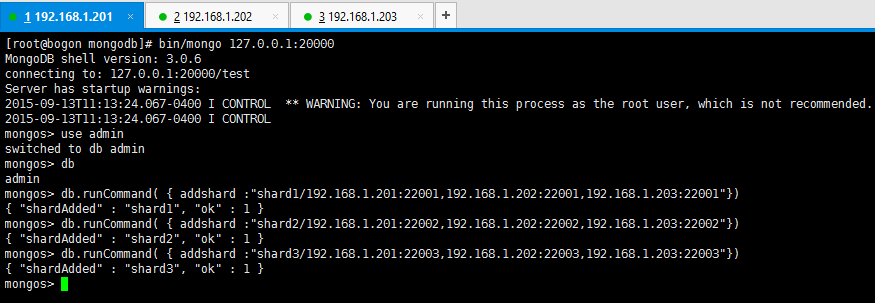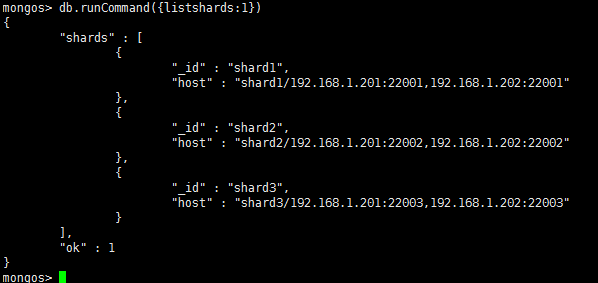标签:
架构图:

1.准备机器,IP分别设置为
192.168.1.201 192.168.1.202 192.168.1.203
2.在每个机器上下载mongodb
3.在每个机器上建立mongos.config,shard1,shard2.shard3五个文件夹
mongos:数据库集群请求的入口(生产环境应有多个)
config:配置服务器,存储所有数据库元信息(路由、分片)的配置(对应mongos)
shard1:分片1
shard2:分片2
shard3:分片3
(mongos 3个, config server 3个,数据分3片 shard server 3个,每个shard 有一个副本一个仲裁也就是 3 * 2 = 6 个,总共需要部署15个实例)
创建日志文件和数据文件(mongos文件不存数据)
#建立mongos目录 mkdir -p mongos/log
#建立config server数据文件存放目录和日志目录 mkdir -p congif/data mkdir -p congif/log
#建立shard1数据文件存放目录和日志目录 mkdir -p shard1/data mkdir -p shard1/log
#建立shard2数据文件存放目录和日志目录 mkdir -p shard2/data mkdir -p shard2/log
#建立shard3数据文件存放目录和日志目录 mkdir -p shard3/data mkdir -p shard3/log

4.端口设定(开启每个机器所对应端口防火墙:iptables -I INPUT -p tcp --dport 20000 -j ACCEPT)
mongos:20000 config:21000 shard1:22001 shard2:22002 shard3:22003
5.启动每一台服务器配置服务器
bin/mongod --configsvr --dbpath config/data --port 21000 --logpath config/log/mongod.log --fork

6.启动每一台服务器mongos服务器
bin/mongos --configdb 192.168.1.201:21000,192.168.1.202:21000,192.168.1.203:21000 --port 20000 --logpath mongos/log/mongos.log --fork
7.启动配置每个模块中的副本集
#在每个机器里分别设置分片1服务器及副本集shard1 bin/mongod --shardsvr --replSet shard1 --port 22001 --dbpath shard1/data --logpath shard1/log/shard1.log --fork --nojournal --oplogSize 10
#在每个机器里分别设置分片2服务器及副本集shard2 bin/mongod --shardsvr --replSet shard2 --port 22002 --dbpath shard2/data --logpath shard2/log/shard2.log --fork --nojournal --oplogSize 10
#在每个机器里分别设置分片3服务器及副本集shard3 bin/mongod --shardsvr --replSet shard3 --port 22003 --dbpath shard3/data --logpath shard3/log/shard3.log --fork --nojournal --oplogSize 10

8.分别对每个分片配置副本集
#任意一台机器
#设置第一个分片副本集、连接shard1
bin/mongo 192.168.1.201:22001
#使用admin数据库
use admin
#定义副本集配置
config = { _id:"shard1", members:[
{_id:0,host:"192.168.1.201:22001"},
{_id:1,host:"192.168.1.202:22001"},
{_id:2,host:"192.168.1.203:22001",arbiterOnly:true}
]
}
#初始化副本及:
rs.initiate(config);

#设置第二个分片副本集、shard2
bin/mongo 192.168.1.201:22002
#使用admin数据库
use admin
#定义副本集配置
config = { _id:"shard2", members:[
{_id:0,host:"192.168.1.201:22002"},
{_id:1,host:"192.168.1.202:22002"},
{_id:2,host:"192.168.1.203:22002",arbiterOnly:true}
]
}
#初始化副本及:
rs.initiate(config);
#设置第三个分片副本集、shard3
bin/mongo 192.168.1.201:22003
#使用admin数据库
use admin
#定义副本集配置
config = { _id:"shard3", members:[
{_id:0,host:"192.168.1.201:22003"},
{_id:1,host:"192.168.1.202:22003"},
{_id:2,host:"192.168.1.203:22003",arbiterOnly:true}
]
}
#初始化副本及:
rs.initiate(config);
9.设置分片配置,让分片生效
#连接mongos
bin/mongo 192.168.1.201:20000
#使用admin数据库
use admin
#串联路由服务器、分配副本集
db.runCommand( { addshard :"shard1/192.168.1.201:22001,192.168.1.202:22001,192.168.1.203:22001"})
db.runCommand( { addshard :"shard2/192.168.1.201:22002,192.168.1.202:22002,192.168.1.203:22002"})
db.runCommand( { addshard :"shard3/192.168.1.201:22003,192.168.1.202:22003,192.168.1.203:22003"})

#查看分片服务器的配置
db.runCommand( { listshards : 1 } );

10.连接在mongos上,准备让指定的数据库、指定的集合分片生效
#指定testdb分片生效
db.runCommand( { enablesharding :"testdb"});
#指定数据库里需要分片的集合和片键
db.runCommand( { shardcollection : "testdb.person",key : {x: 1} } )

11.java程序与集群关联
List<ServerAddress> addresses = new ArrayList<ServerAddress>();
addresses.add(new ServerAddress("192.168.1.201" , 20000));
addresses.add(new ServerAddress("192.168.1.202" , 20000));
addresses.add(new ServerAddress("192.168.1.203" , 20000));
MongoClient client = new MongoClient(addresses);
MongoDatabase db = client.getDatabase( "testdb" );
MongoCollection coll = db.getCollection( "person" );
long start = System.currentTimeMillis();
System.out.println("start:"+start);
List<Document> add = new ArrayList<Document>();
for(int i=1; i<400000; i++){
add.add(new Document().append("x", i).append("name", "daxiong"+i));
}
coll.insertMany(add);
/* FindIterable<Document> findInterable = coll.find();
for(Document d : findInterable){
System.out.println(d.toJson());
}*/
System.out.println("耗时:"+(System.currentTimeMillis() - start)/1000);
#查看分片状态命令 db.person.stats(); db.printShardingStatus()
12.重启服务器后,再次启动mongodb集群命令
#1.启动每个config service bin/mongod --configsvr --dbpath config/data --port 21000 --logpath config/log/mongod.log --fork #2.启动每个mongos(搭载所有config) bin/mongos --configdb 192.168.1.201:21000,192.168.1.202:21000,192.168.1.203:21000 --port 20000 --logpath mongos/log/mongos.log --fork #3.启动每个机器的每个分片、副本集群、仲裁 bin/mongod --shardsvr --replSet shard1 --port 22001 --dbpath shard1/data --logpath shard1/log/shard1.log --fork --nojournal --oplogSize 10 bin/mongod --shardsvr --replSet shard2 --port 22002 --dbpath shard2/data --logpath shard1/log/shard2.log --fork --nojournal --oplogSize 10 bin/mongod --shardsvr --replSet shard3 --port 22003 --dbpath shard3/data --logpath shard1/log/shard3.log --fork --nojournal --oplogSize 10 #4.连接任意mongos
参考:http://www.lanceyan.com/tech/arch/mongodb_shard1.html
标签:
原文地址:http://my.oschina.net/daxiong0615/blog/505822